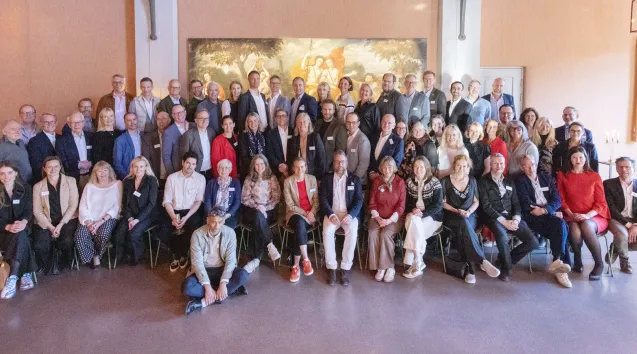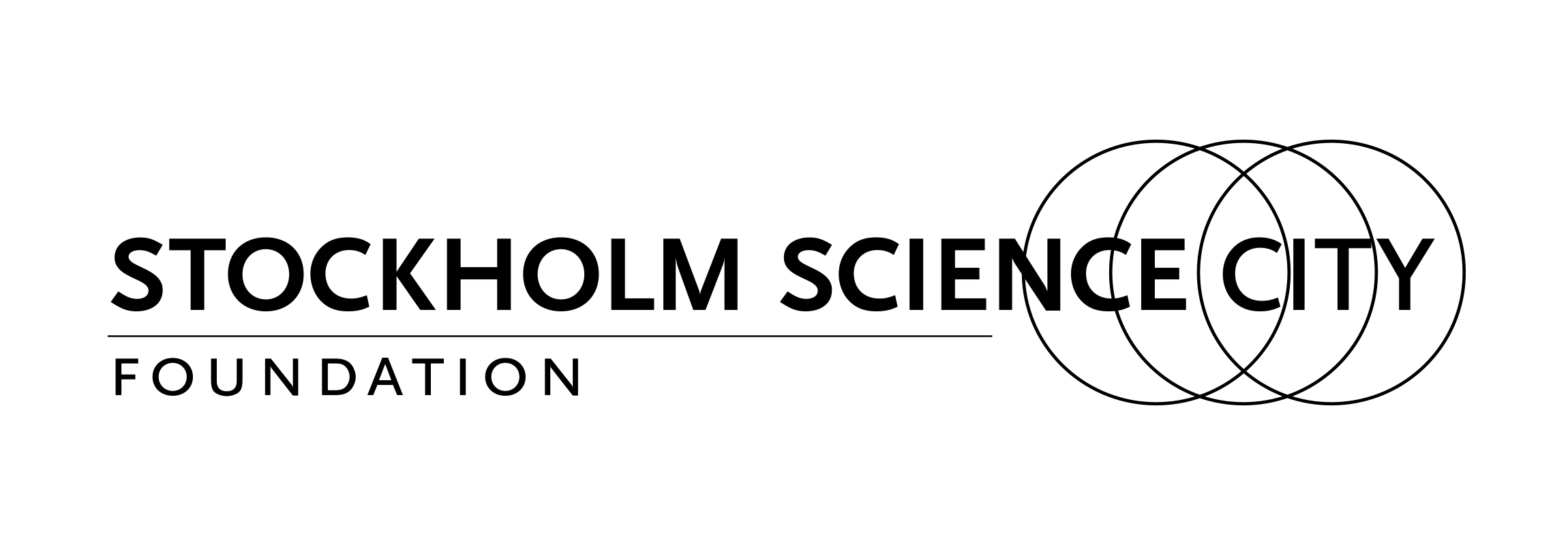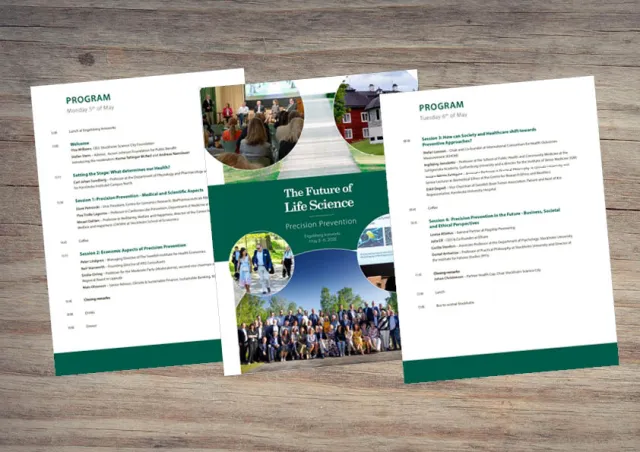Program 2025
Engelsberg Ironwork, May 5-6, 2025
Monday May 5
9:30 Bus from central Stockholm to Engelsberg Ironworks
12:00 Lunch at Engelsberg Ironworks
13:00 Welcome
13:15 Setting the stage: What determines our health?
Carl Johan Sundberg, Professor at the Department of Physiology and Pharmacology and Dean for Karolinska Institutet Campus North.
13:30 Session one: Precision Prevention - medical and scientific aspects
- How are novel diagnostic tools and AI-driven risk prediction models shaping the future of precision prevention?
- How can healthcare systems integrate precision prevention into routine care?
- What tools are available for society and healthcare to work with prevention?
- Does awareness of our health status and risk factors contribute to greater well-being, or can it have unintended consequences?
Slavé Petrovski, Vice President, Centre for Genomics Research, BioPharmaceuticals R&D at AstraZeneca.
Ylva Trolle Lagerros, Professor in Cardiovascular Prevention, Department of Medicine at Karolinska Institutet.
Micael Dahlen, Professor in Wellbeing, Welfare and Happiness. Director of the Center for Wellbeing, Welfare and Happiness (CWWH) at Stockholm School of Economics.
14:45 Coffee
15:15 Session two: Economic aspects of precision prevention
- What are the advantages and challenges of different reimbursement models in healthcare? Which models best incentivize preventive care?
- What lessons can we draw from real-world cases of outcome-based compensation in healthcare?
- How can health bonds be leveraged to finance and promote preventive interventions in healthcare systems?
- How can successful pilots be scaled?
Peter Lindgren, Managing director of The Swedish Institute for Health Economics and Adjunct Professor, Department of Learning, Informatics, Management and Ethics at Karolinska Institutet.
Neil Stanworth, Founding Director of ATQ Consultants.
Emilie Orring, Group leader for Moderaterna (The Moderate Party) and second vice chairman of the Regional Board in Uppsala.
Mats Olausson, Senior Advisor, Sustainable Products at SEB.
16:40 Closing remarks
18:00 Drinks
19:00 Dinner
Tuesday 6th of May
8:30 Session three: How can society and healthcare systems transition toward more effective preventive approaches?
- How can the impact of preventive interventions be effectively measured?
- What is required from the systems that are delivering health to be able to transition preventive approaches?
- Which stakeholders in society are key to driving the transition toward prevention?
- What responsibility do individuals and different parts of society have when it comes to health?
Stefan Larsson, Chair and cofounder of Consortium for Health Outcomes Measurement (ICHOM).
Ingibjörg Jonsdottir, Professor at the School of Public Health and Community Medicine at the Sahlgrenska Academy, Gothenburg University. Director for the Institute of Stress Medicine (ISM).
Jessica Nihlén Fahlquist, Associate Professor in Practical Philosophy and Senior Lecturer in Biomedical Ethics at the Centre for Research Ethics and Bioethics at Uppsala University.
Eskil Degsell, Vice Chairman of Swedish Brain Tumor Association. Patient and Next of Kin Representative, Karolinska University Hospital.
09:45 Coffee
10:15 Session four: Precision prevention in the future – business, societal and ethical perspectives
- What new business opportunities are emerging in the field of precision prevention?
- Is there an increasing demand for precise preventive services in the market? Who will lead the development of this market?
- What factors in our environment are most important for our health and well-being? How can we build healthier societies based on current knowledge?
- What are the key drivers and challenges in the transition to precision prevention?
Lovisa Afzelius, General partner at Flagship Pioneering.
Cecilia Stenfors, Associate Professor, Department of Psychology at Stockholm University.
Gustaf Arrhenius, Professor of Practical Philosophy at Stockholm University and Director of the Institute for Futures Studies (IFFS).
Julia Elf, CEO & Co-founder at Elfcare.
11.45 Closing remarks
12:00 Lunch at Engelsberg Ironworks
13:00 Bus to central Stockholm
About the 16 speakers

Afzelius, Lovisa, General Partner at Flagship Pioneering. She has co-founded seven companies operating at the intersection of biology and AI, including Alltrna, Apriori Bio, Metaphore Biotechnologies, and Prologue Medicines. Lovisa has served as CEO, co-founder, president, board chairman, and executive director in emerging biotech and large pharma companies. Prior to Flagship, Lovisa held leadership roles at Pfizer and Astra Zeneca for 15+ years, developing drugs, including several on the market in the autoimmunity space. Lovisa has a PhD in computational chemistry from Uppsala University, an MS in integrative pharmacology from Gothenburg University, and an MBA from the MIT Sloan School of Management.
Arrhenius, Gustaf, Director of the Institute for Futures Studies (IFFS) since 2015 and Professor of Practical Philosophy at Stockholm University. He holds a Ph.D. in Philosophy from University of Toronto and a doctorate in Practical Philosophy from Uppsala University. His research focuses on moral and political philosophy, particularly on what we owe to future generations, democratic theory, and fair distribution of power. He has been a visiting researcher at many institutions, such as the University of Oxford and CNRS. He is a member of Academia Europaea and serves on the board of Sweden’s Health and Social Care Analysis Agency and UUniCORN at Uppsala University.
Dahlen, Micael, holds the Chaired Professor in Wellbeing, Welfare and Happiness and is the Center for Wellbeing, Welfare and Happiness (CWWH) director at Stockholm School of Economics. Micael has a particular interest in what constitutes a good life and how truly good economics, in which the actions of and exchanges between individuals, organizations, and society have extended and synergetic effects, can make a good life for all.
Degsell, Eskil, is an open-experienced patient and next of kin, vice chairman of the Swedish Brain Tumor Association. Patient- and next of kin representative at malignant brain tumour Pathway at Karolinska University Hospital. Project leader of a complex intervention that aims to see and strengthen all roles and relationships (Socialomics) and development, evaluation and implementation of Symptomics in patients’ daily life and clinical routine in cancer. Affiliated to research at Karolinska Institutet (PCM program) and Gothenburg University (GPCC). Associated to Biobank Sweden. Member of Editorial Board at Journal of Integrated Care.
Elf, Julia, founder and CEO of Elfcare. She has a technical background from KTH and broad experience in digital health, including from her time at Kry. In addition to her operational work, she is also active as an angel investor. Elfcare was founded in 2025 by Julia Elf and Johannes Schildt (founder of Kry) with the goal of offering accessibility to the most advanced diagnostics and technology for the early detection of serious diseases. Thanks to advancements in compute, data, and technology, the opportunities to work proactively with health have never been greater – forming the foundation of the company’s vision. Today, they offer full-body MRI with AI analysis, comprehensive blood tests, and in-depth medical examinations in eight Swedish cities.
Jonsdottir, Ingibjörg, Professor at the School of Public Health and Community Medicine at the Sahlgrenska Academy, Gothenburg University and Director for the Institute of Stress Medicine (ISM). ISM is a research institute located in the western part of Sweden that works with different aspects of work-related stress, including clinical research and research on organisational and social work environments. Ingibjörg is involved in projects related to clinical research focusing on individuals with burnout/exhaustion, as well as research focusing on organisational and social work environments.

Larsson, Stefan, Chair and cofounder at International Consortium for Health Outcomes Measurement (ICHOM). Stefan Larsson, MD, PhD., trained at Karolinska Institutet, Harvard Medical School and MRC Human Genomics unit in UK, an Associate Professor at KI. He worked at The Boston Consulting Group 1996 -2021. He was the founder and first leader of BCG’s Global Payer and Provider sector and its Health Systems sector. He led BCG’s work on Value based health care. Stefan is a co-founder and the board chair of ICHOM, International Consortium of Health Outcomes Measurement, an independent not-for-profit organisation. He is a Distinguished Fellow with the World Economic Forum. He published the book “The Patient Priority” and has >30 peer reviewed papers.
Lindgren, Peter, Managing director of The Swedish Institute for Health Economics and Professor of health economics at Karolinska Institutet. Peter has over 20 years of experience in Swedish and international health economic studies across various fields, with nearly 100 scientific publications, and has held leading roles in consulting and R&D activities. Since finishing his PhD on the economics of cardiovascular prevention, the area of prevention has always been close to his heart.
Nihlén Fahlquist, Jessica, Associate Professor in Practical Philosophy and a Senior Lecturer in Biomedical Ethics at the Centre for Research Ethics and Bioethics at Uppsala University. She holds a PhD in Philosophy from the Royal Institute of Technology and has conducted postdoctoral research at Delft University of Technology. Her work focuses on moral responsibility, public health, and technology. She also teaches ethics in medical and biotechnology programs and leads master's courses in public health ethics.
Olausson Mats, Senior Advisor, Climate & Sustainable Finance, Sustainable Banking, SEB. His primary responsibilities include tailored advisory on green and social bonds, sustainability linked loans and bonds as well as other sustainable finance opportunities such as Health Impact Bonds to issuers, investors and other stakeholders. Mats has provided structural advice to over 80 clients in developing frameworks for sustainable finance solutions within various sectors and regions. Prior to joining SEB, he worked for UNDP in Bolivia and at SIDA. Mats has a Bachelor of Social Science with a major in Economics (coupled with Development Studies and Spanish) from Stockholm University.
Orring, Emilie, Group leader for Moderaterna (Moderate Party) since January 2020 and second vice chairman of the Regional Board in Uppsala. She served as Chair of the Regional Executive Board in Region Uppsala from January 2020 to February 2024, becoming the first woman in this position. After a new administration was formed without the Moderates, she became the second vice chair of the Regional Executive Board and an opposition councillor. She studied at Uppsala and Lund University, earning a Bachelor of Political Science and a Bachelor of Economics in Commercial Law. She has previously worked as a political secretary in Uppsala Municipality and at the Swedish Migration Agency.

Petrovski, Slavé, Vice President, Head of Genome Analytics and Bioinformatics, R&D at AstraZeneca. Human geneticist by training with over 15 years’ experience leading large-scale omics studies. In this time, Slavé has contributed to shaping the field of contemporary population and statistical genomics, including introducing machine learning & advanced analytics to identify numerous drug targets across a diverse range of diseases. At AstraZeneca, Slavé is accountable for architecting and delivering the company’s Genomics Initiative strategy. He has built in-house capabilities and expertise across key domains: Bioinformatics, Statistical Genetics, Innovative AI/ML methods, multi-omics, and clinical sciences. Applying these cross-disciplinary skills to large-scale omics datasets.
Stanworth, Neil, Founding Director of ATQ Consultants, specialising in outcome-based commissioning including social outcomes contracts (SOCs) and social impact bonds (SIBs). He has worked extensively with commissioners and providers to develop SOCs, SIBs and other innovative contracts. He is also an experienced researcher and evaluator of SOCs and SIBs for the UK government and is leading the evaluation of the Commissioning Better Outcomes Fund (CBO) in partnership with Ecorys UK. Neil is a former fellow of practice at the Government Outcomes Lab (GO Lab), part of Oxford University, and contributes regularly to GO Lab guidance and events.
Stenfors, Cecilia, Associate Professor, researcher, and university lecturer at the Department of Psychology, Stockholm University, where she leads the Stenfors Lab. Her research focuses on the interplay between human, environmental, and planetary health and sustainability. Studies explore the interconnection between our environments and human health, cognition and well-being. She leads projects examining how different natural and urban environment exposures, as well as work-life factors, affect health and wellbeing — both before and during the Covid-19 pandemic.
Sundberg, Carl Johan, Professor at the Department of Physiology and Pharmacology at Karolinska Institutet and Dean for Karolinska Institutet Campus North. His research focuses on the effects and role of physical activity in the prevention and treatment of disease. He is elected to the Royal Swedish Academy of Engineering Sciences and has been a member or chairman of numerous academic and industry boards.
Trolle Lagerros, Ylva, Holds the Prince Daniel Professorship in Cardiovascular Prevention at Karolinska Institutet. She is a specialist in internal medicine with a focus on obesity. Her research spans from how lifestyle habits influence the risk of cardiovascular disease to clinical studies and intervention studies aimed at implementing and maintaining healthy lifestyle habits in at-risk groups.
Moderators:

Namslauer, Andreas, Process Manager at Stockholm Science City.
Tellinger McNeil, Karina, e-health strategist at Swedish Association of Local Authorities and Regions.
Stockholm Science City Foundation is arranging the symposium in collaboration with Axel and Margaret Ax:son Johnson Foundation.

Practical information
The symposium takes place at the World Heritage Site of Engelsberg Ironworks.

Previous symposia
Here you find the reports and recordings from the previous symposiums.

The Future of Life Science
An annual symposium series where experts from diverse fields explore how breakthroughs in life science are shaping individuals, society, and healthcare — today and into the future.




